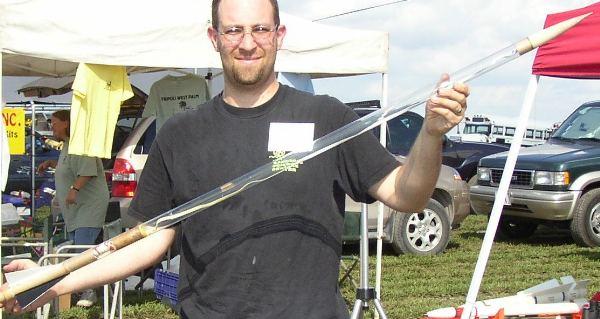Vaughn Brothers Extreme 29mm - Night
Vaughn Brothers - Extreme 29mm - Night {Kit}
Contributed by Scott Simka
| Manufacturer: | Vaughn Brothers |
Brief:
After a prang from 3000 feet of my VB Extreme 29mm, the only surviving parts
were the fin section, 2 launch lugs, nose cone and bulkhead/eyebolt. A 24mm
adapter was epoxied in, a clear fluorescent light tube cover was slipped over
the fin tube and the nose cone slid into the other end, with a wrap of tape
around the shoulder. Rear Ejection was the final modification.

Modifications:
The Fin section of body tube was cut just at the CP mark which was about 1 inch
above the G10 fins. The 1 inch above the G10 fins needed to be unwrapped
slightly to slide into the plastic light tube cover. There are 2 sizes of
fluorescent light cover, a wider tube and a narrower tube. I used the narrow
one.
Into the forward end of the fin section, a small piece of stainless steel scrubber was secured to act as a baffle. The distance between the baffle in the fin section, and the bulkhead in the clear tube section was about 5 inches. This 5 inches held 2 feet of shock cord and a 6 inch nylon parachute very tightly wrapped.
The entire body above the fins is crystal clear and the shock cord hangs down.
As many as 3 Cyalume light sticks can be taped to the long section of shock cord (that attaches the nose cone). At ejection, the fin section blows back and pulls out the parachute. The design has flown on D12-5 and E9-6 motors with great stability.
The same 3 fins that came with the original kit were used. On initial assembly, the fins were epoxied canted 10 degrees off line which resulted in a rapid spin upon ascent.
The plywood bulkhead was epoxied into the clear plastic fluorescent light tube cover with the eyebolt facing forward. Approx. 40 inches of 1/4 inch elastic were connected after curing, to the nose cone. The nose cone required a wrap of masking tape to sit snug in the end of the plastic tube.
The rocket is not especially sturdy, the fluorescent light tube cover is somewhat flexible. The design, for night flights would probably withstand Composite E motors. This worked out especially well because I had been looking for a Night Flight design. All the parts fit perfectly.
Flight:
Nice recovery on 2 flights, D12-5 and E9-6. Recovery appears sloppy because the
forward section is 50 inches and the rear section is only 10. It's meant to
recover at night, so that aspect wouldn't be visible.
Summary:
The VB-29 has a strong potential for recovery failure because of the minimum
diameter tube and the size of the included parachute. The 'chute can easily
wind up being "Stuffed."
The parts recovered are great and can be used easily.
 |
 |